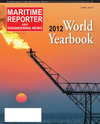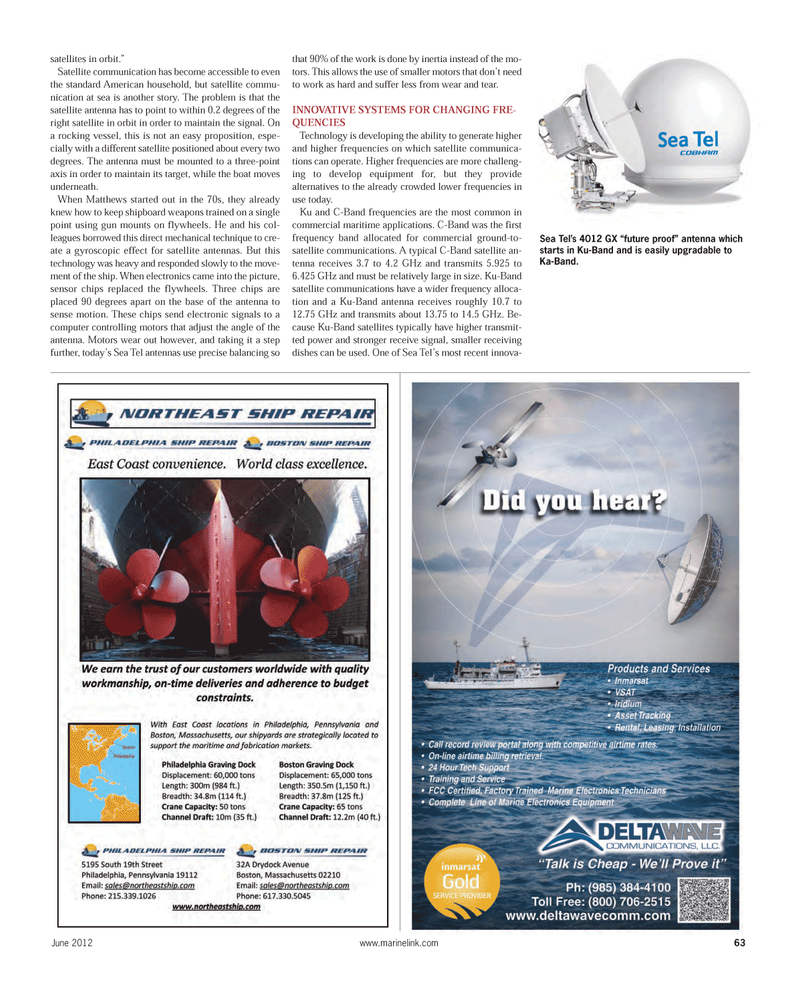
Page 63: of Maritime Reporter Magazine (June 2012)
Annual World Yearbook
Read this page in Pdf, Flash or Html5 edition of June 2012 Maritime Reporter Magazine
satellites in orbit.? Satellite communication has become accessible to even the standard American household, but satellite commu- nication at sea is another story. The problem is that the satellite antenna has to point to within 0.2 degrees of the right satellite in orbit in order to maintain the signal. Ona rocking vessel, this is not an easy proposition, espe- cially with a different satellite positioned about every two degrees. The antenna must be mounted to a three-point axis in order to maintain its target, while the boat moves underneath.When Matthews started out in the 70s, they already knew how to keep shipboard weapons trained on a single point using gun mounts on flywheels. He and his col-leagues borrowed this direct mechanical technique to cre- ate a gyroscopic effect for satellite antennas. But this technology was heavy and responded slowly to the move- ment of the ship. When electronics came into the picture, sensor chips replaced the flywheels. Three chips are placed 90 degrees apart on the base of the antenna to sense motion. These chips send electronic signals to a computer controlling motors that adjust the angle of theantenna. Motors wear out however, and taking it a step further, today?s Sea Tel antennas use precise balancing so that 90% of the work is done by inertia instead of the mo- tors. This allows the use of smaller motors that don?t need to work as hard and suffer less from wear and tear. INNOVATIVE SYSTEMS FOR CHANGING FRE- QUENCIESTechnology is developing the ability to generate higher and higher frequencies on which satellite communica-tions can operate. Higher frequencies are more challeng-ing to develop equipment for, but they provide alternatives to the already crowded lower frequencies in use today. Ku and C-Band frequencies are the most common in commercial maritime applications. C-Band was the first frequency band allocated for commercial ground-to- satellite communications. A typical C-Band satellite an- tenna receives 3.7 to 4.2 GHz and transmits 5.925 to 6.425 GHz and must be relatively large in size. Ku-Band satellite communications have a wider frequency alloca- tion and a Ku-Band antenna receives roughly 10.7 to 12.75 GHz and transmits about 13.75 to 14.5 GHz. Be-cause Ku-Band satellites typically have higher transmit- ted power and stronger receive signal, smaller receiving dishes can be used. One of Sea Tel?s most recent innova- June 2012www.marinelink.com 63Sea Tel?s 4012 GX ?future proof? antenna which starts in Ku-Band and is easily upgradable to Ka-Band. MR June12 # 8 (57-64):MR Template 6/13/2012 9:46 AM Page 63

 62
62

 64
64
